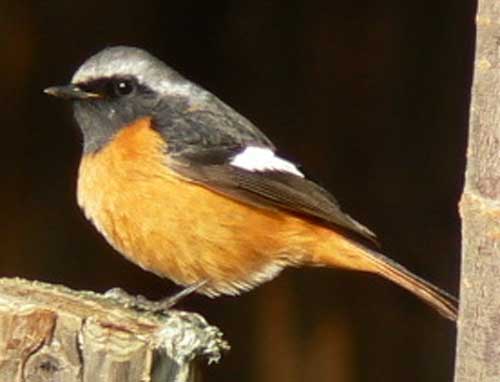Phoenicurus auroreus (*) Cladus: Eukaryota Name Phoenicurus auroreus (Pallas, 1776) References * Reise durch verschiedene Provinzen des Russischen Reichs 3 p.695 Vernacular names ---------------- The Daurian Redstart (Phoenicurus auroreus) is a small passerine bird from temperate Asia. In Japan, it is known as jōbitaki (ジョウビタキ). Description and systematics Like all typical redstarts, they are strongly sexually dimorphic. Breeding males have a grey crown and nape with lighter forehead and crown-sides, a black face and chin, brownish mantle and wings and a large white wing patch; the chest, lower back and rump are orange, and the tail is black with orange sides. Juvenile males are similarly patterned but much duller and less clearly marked.[1] It was formerly classed as a member of the Thrush family (Turdidae), but is now generally considered to be an Old World flycatcher (Muscicapidae). This species is divided into two subspecies, the eastern P. a. auroreus and the western P. a. leucopterus. It belongs to a close-knit Eurasian clade which also includes the Black Redstart (P. ochruros), Hodgson's Redstart (P. hodgsoni), the White-winged Redstart (P. erythrogastrus) – which may be especially closely related to P. auroreus –, and maybe the Ala Shan Redstart (P. alaschanicus). These all diverged during the latter part of the Late Pliocene and the earliest Early Pleistocene, some 3-1.5 million years ago, during onset of the Quaternary glaciation.[2] Distribution and ecology It is a fairly common bird in East Asia, ranging eastwards from Mongolia and the Himalayas. It is migratory; P. a. auroreus winters in Korea, Japan, southeast coastal China and Taiwan, and P. a. leucopterus in northern India and parts of Southeast Asia.[3] Daurian Redstarts favour open forests, forest edges, agricultural margins, and are also commonly found in parks and urban gardens. They are reasonably confiding and often allow humans to approach quite closely before moving off. It breeds in the summer months, with a mated pair of the nominate subspecies having been encountered in early May.[4] Widespread and rather common, this bird is not considered a threatened species by the IUCN.[5] Footnotes 1. ^ a b Brazil (2008)
Source: Wikispecies, Wikipedia: All text is available under the terms of the GNU Free Documentation License |
|

